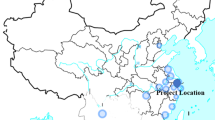Abstract
In recent years, many researchers have considered the mechanical characteristics of deep foundation excavation in soft-soil. The analysis of these deep excavations requires consideration of an uncertain, nonlinear, dynamic and complicated system, and involves consideration of soil strength, stability, deformation, fluid flow and interaction of soil and different retaining configurations. It is difficult to describe such a nonlinear system using traditional analysis. Therefore, in order to accurately describe the mechanical behavior of a representative deep excavation of the subway station, in this case, 3-Dimensional geotechnical numerical analysis method using FLAC3D software was applied. Using this tool, a study considering earth pressure, soil deformation and settlement was carried out. Furthermore, the response of different retaining configurations was deeply investigated. Triaxial cement mixing piles were considered as a way to optimize deformation of the deep excavation and reduce settlement of the ground surface and the railway embankment. The analysis indicated that the deeper the foundation excavation was, the larger the surface settlement and the smaller the earth pressure. The analysis also considered the mechanical effect of varying the wall thickness and the wall depth on the structure‘s deformation characteristics. The simulations indicated that a wall thickness of less than 1.4 m effectively reduced wall horizontal displacement, ground surface settlement and uneven settlement of railway embankment. While a variable wall embedded depth that was less than 52 m also changed the settlement of the excavation deformation and the ground surface. Therefore, the numerical results can agree with the practical project to imply that numerical method in the paper is applicable and reliable, which provides a new thought to research on deep excavation in soft-soil.





















Similar content being viewed by others
References
Chen Y, Xu D (2008) Theory and practical engineering application [M]. China Water Power Press, Beijing
China Academy of Building Research (1999) China technical specification of retaining and protection of building foundation excavation (JGJ 120-99). China Building Press, Beijing
Comodromos EM, Papadopoulou MC, Rentzeperis IK et al (2009) Pile foundation analysis and design using experimental data and 3-D numerical analysis. Comput Geotechn V36(5):819–836
Danziger FAB, Danziger BR (2006) The simultaneous use of piles and prestressed anchors in foundation design. Eng Geol V87(3–4):163–177
Huang C-C, Luo W-M (2009) Behavior of soil retaining walls on deformable foundations. Eng Geol V105(1–2):1–10
Itasca Consulting Group (2002) FLAC3D V3.0: thoery and background-Interfaces. Itasca Consulting Group, Minneapolis
Johnson K, Lemcke P et al (2006) Modelling the load–deformation response of deep foundations under oblique loading. Environ Model Softw V21(9):1375–1380
Kim CY, Bae GJ et al (2001) Neural network based prediction of ground surface settlements due to tunnelling. Comput Geotech V28(6–7):517–547
Mullapudi R, Ayoub A (2010) Nonlinear finite element modeling of beams on two-parameter foundations. Comput Geotech V37(3):334–342
Ocak I (2008) Control of surface settlements with umbrella arch method in second stage excavations of Istanbul Metro. Tunn Undergr Space Technol V 23(6):674–681
Potyondy JG (1961) Skin friction between various soils and construction Materials[J]. Geotechnique 11(4):339–353
Shariatmadari N, Chaichi P et al (2006) The survey of ground surface settlement caused by cut and cover tunnel excavation in Tabriz subway. Tunn Undergr Space Technol V21:455–463
Sou-Sen L, Hsien-Chuang L (2004) Neural-network-based regression model of ground surface settlement induced by deep excavation. Autom Constr V13(3):279–289
Suwansawat S, Einstein HH (2006) Artificial neural networks for predicting the maximum surface settlement caused by EPB shield tunneling. Tunn Undergr Space Technol V21(2):133–150
The First Reconnaissance and Design Research Institute of China Railway (2005) China code for design on subgrade of railway (TB10001–2005). China Railway Press, Beijing
The First Reconnaissance Design Research Institute of China Railway (2007) China code for geology investigation of railway engineering (TB10002–2007). China Railway Press, Beijing
Acknowledgments
The authors are very grateful to Dr. Catherine O’sullivian at Imperial College London for her help revising the paper. And the study was financially supported by ‘985 Engineering Program’ Foundation with Grant No. 0903005104973, Young Teachers’ Creation Foundation at Chongqing University, Project No. CDJZR11 20 00 13 supported by the Fundamental Research Funds for the Central Universities and No. 51109231 supported by National Natural Science Foundation of China. We also gratefully acknowledge the numerical analysis carried out by our research group.
Author information
Authors and Affiliations
Corresponding author
Rights and permissions
About this article
Cite this article
Liu, X., Liu, S. Study on Deformation Characteristics of Deep Foundation Excavation in Soft-Soil and the Response of Different Retaining Configurations. Geotech Geol Eng 30, 313–329 (2012). https://doi.org/10.1007/s10706-011-9470-5
Received:
Accepted:
Published:
Issue Date:
DOI: https://doi.org/10.1007/s10706-011-9470-5




